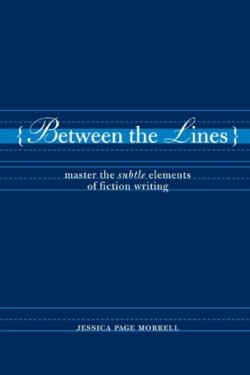Between the Lines
Master the Subtle Elements of Fiction Writing
Many writing books help with the act of writing; this one helps with the art of it. Using her experience as a writer, editor, and teacher, the author has gone beyond the mere constructs of plot and characterization to ferret out the finer points of fiction writing that bring stories to life.
Morrell compares writing fiction to cooking. Main ingredients—such as the dramatic question, obstacles, conflict, unity, and a satisfying ending—are the foundation of all good stories. What takes a dish beyond the ordinary, however, are the spices that each chef chooses to flavor it with. She challenges writers to master more subtle elements in order to create a more flavorful read.
“Used artfully,” she suggests, “imagery acts almost like a sixth sense, whispering to our reader’s subconscious.” Devices like simile and metaphor, alliteration, and irony create a mood that carries the reader deeper into the story’s world and propels her forward through the pages. They also influence the important aspect of pace in the story. Morrell provides techniques for regulating pace, such as using harsh consonant sounds, short sentences, and no repetition for explosive action scenes … and vowels, flowing sentences, and soft verbs such as soothe and simper during introspective moments.
Setting can also be used effectively to enhance a work of fiction. When going through the editing process, Morrell suggests making the setting “multitask” by using it to indicate an era, create a mood, and cause obstacles for the protagonist. Choosing specific words to describe the location, weather, and time of day will paint a picture that both teems with emotion and furthers the theme of the story.
Morrell was first published at age fifteen; she has written several previous books, including Writing Out the Storm. She works as a freelance editor, teaches writing and creativity classes in the Portland, Oregon area, and has received the Oregon Literary Arts Writers in the School Fellowship. She also coaches clients and students in motivation and technique.
Here, through liberal use of examples from novels and film, as well as various exercises, checklists, and guidelines, Morrell takes an aspiring or experienced writer through elements that can be applied both during the initial writing process and later in the editing stages. She is a proponent of reading to improve writing, and as such, she includes in each chapter a list of novels and films that exhibit the technique that she’s discussing. For instance, she suggests Alfred Hitchcock’s Vertigo for studying foreshadowing or Stephen King’s novella The Body for its sensory details.
Any writer can benefit from adding these ingredients to his or her work. As Morrell points out, “a compelling narrative often lies between the lines, in the quiet moments and the subtlest techniques where fiction lifts off the page and settles into the veins of the reader.”
Reviewed by
Christine Canfield
Disclosure: This article is not an endorsement, but a review. The publisher of this book provided free copies of the book to have their book reviewed by a professional reviewer. No fee was paid by the publisher for this review. Foreword Reviews only recommends books that we love. Foreword Magazine, Inc. is disclosing this in accordance with the Federal Trade Commission’s 16 CFR, Part 255.

